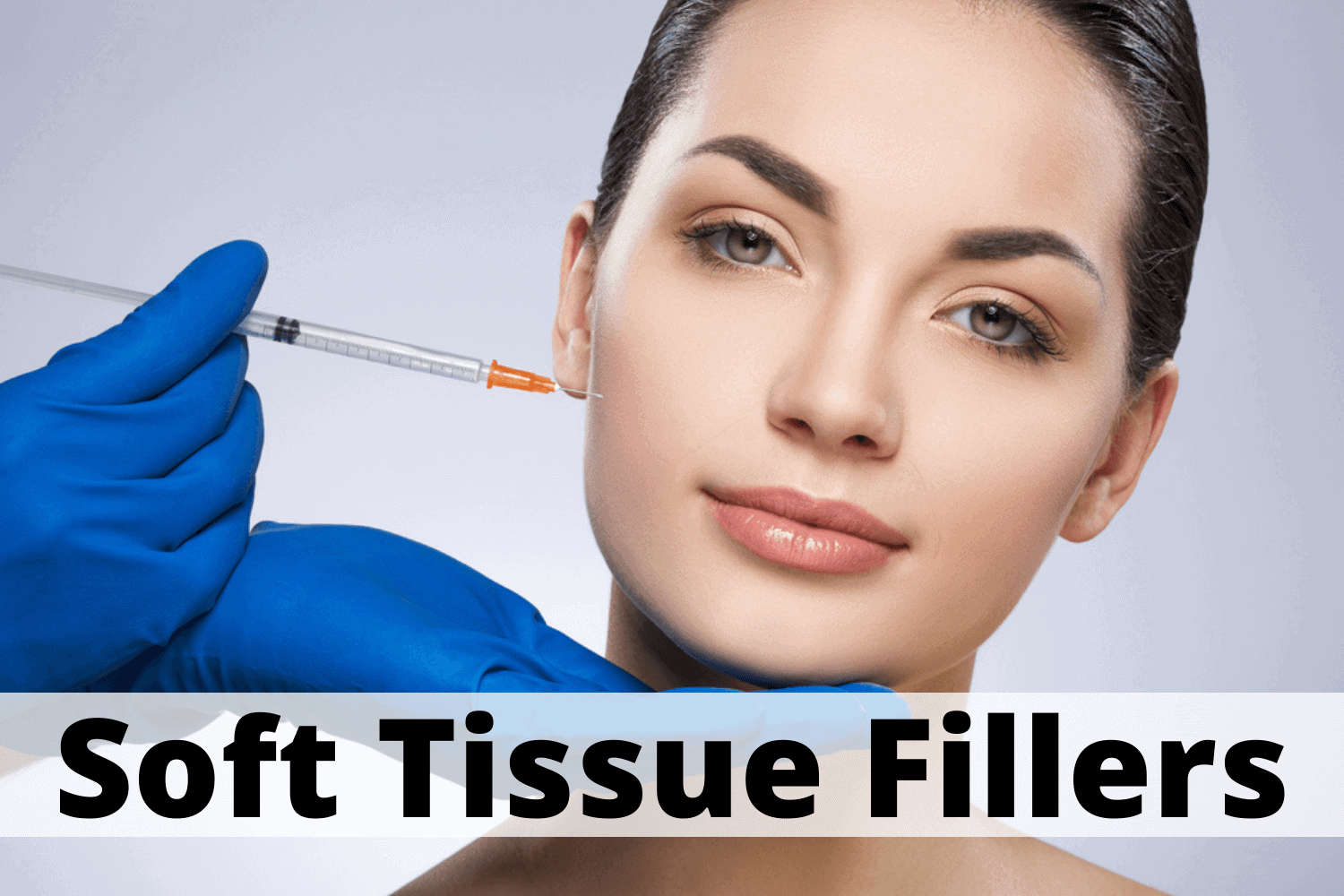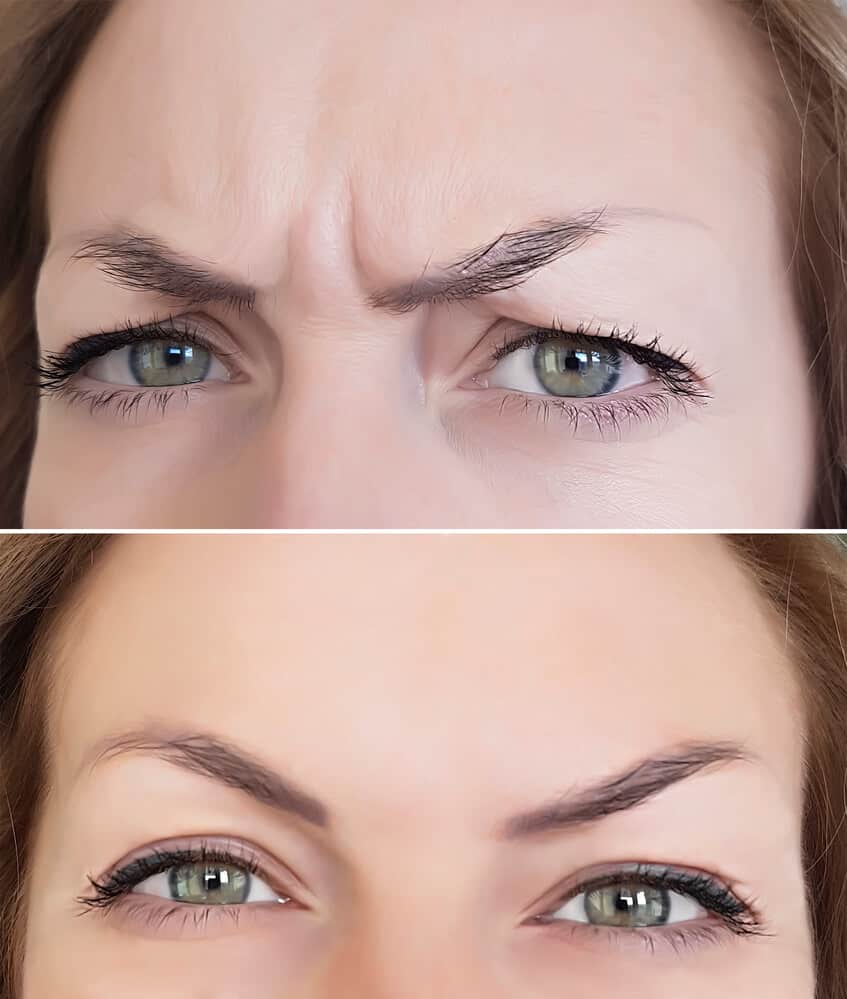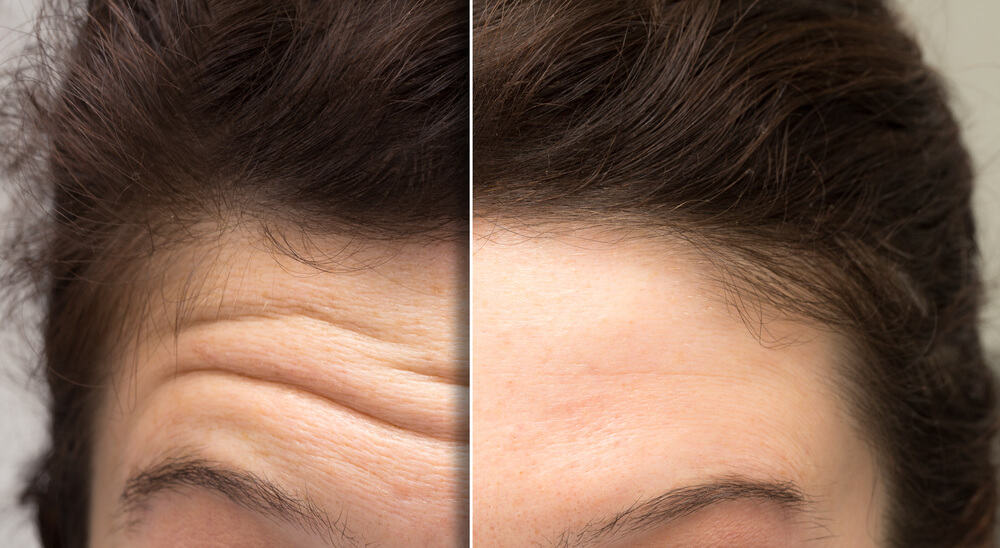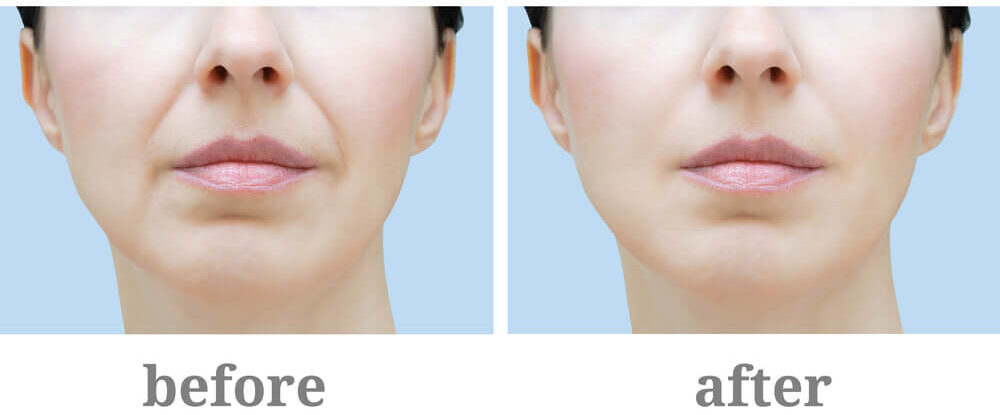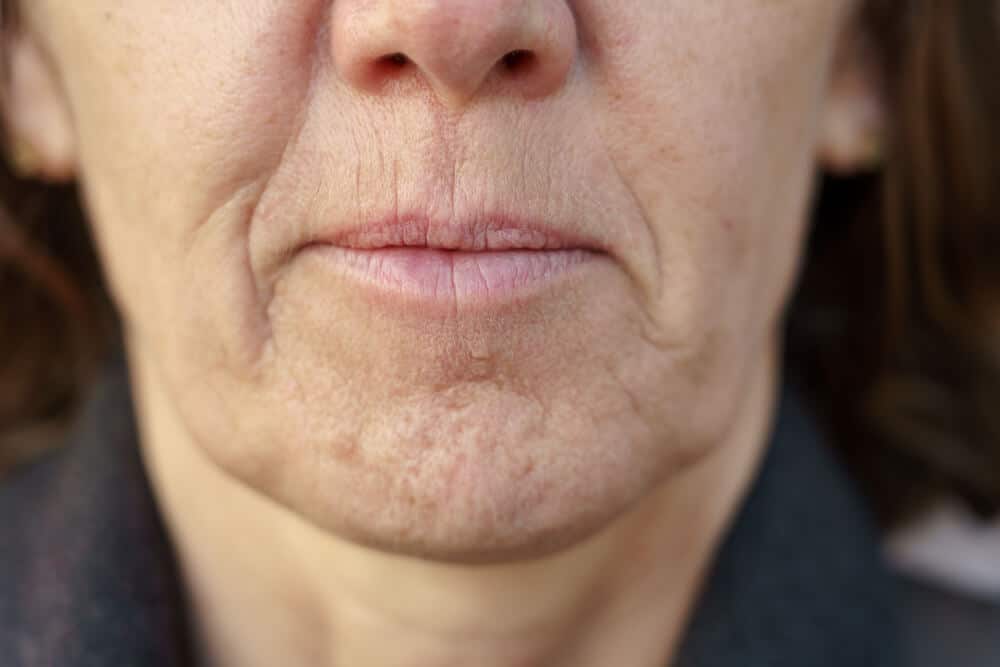12 Popular Cosmetic Uses for Soft Tissue Fillers
Are you interested in learning about how soft tissue fillers can help you look younger? This article will teach you how soft tissue fillers can reduce the appearance of wrinkles on your face, neck, chest, and hands.
As you get older, your skin may begin to lose its volume and produces more wrinkles.
Fortunately, soft tissue fillers are used to restore the volume of the skin on the face, neck, chest, and hands, and temporarily reduce the appearance of wrinkles.
Two types of soft tissue fillers exist on the market today: temporary or permanent soft tissue fillers.
Temporary soft tissue fillers are often called biodegradable absorbable fillers. Permanent soft tissue fillers are called nonabsorbable fillers.
We recommend temporary soft tissue fillers over permanent fillers, especially if this is your first time getting cosmetic facial fillers.
Soft tissue fillers are approved by the Food and Drug Administration (FDA) for treating the following cosmetic conditions:
- Nasolabial folds (smile lines)
- Wrinkles around the lips and mouth
- Acne Scars
- Wrinkles
- Increasing or augmenting the volume of your lips, cheeks, chin, and back of the hand.
Additionally, although not FDA-approved, soft tissue fillers have been used to treat other cosmetic problems including:
- Eyebrow lines (Glabellar lines)
- Forehead lines
- Eyebrow lift
- Hollow Temples
- Under-eye (tear trough) bags and dark circles
- Cheek lift
- Neck and chest wrinkles
As a pharmacist with forehead lines and nasolabial folds, I was excited to research and share how soft tissue fillers can restore your youthful glow.
You are going to learn about the various cosmetic applications of dermal fillers, the different types of dermal fillers that are available, and the safety of dermal fillers.
After reading this article on injectable soft tissue fillers, you will know what to expect from this procedure and be more informed of which filler type is the best for you.
This post is all about the 12 most popular cosmetic uses for soft tissue fillers!
Soft Tissue Fillers: UPPER FACE
1. Eyebrow lines (Glabellar lines)
Glabellar lines are two vertical parallel line creases between your eyebrows that are sometimes called “11” lines because they look like the number 11.
Glabellar lines develop over time as we age and are the result of muscular contractions when we frown.
Cosmetic facial fillers are often used with Botox to reduce the appearance of these wrinkles.
{RELATED POST: 16 Popular Botox Injection Areas for Face and Neck Wrinkles}
2. Forehead lines
Horizontal lines can develop on the forehead as we age due to repetitive upward contractions of the eyebrow muscles.
Fillers or Botox can be used to minimize the appearance of forehead line wrinkles.
{RELATED POST: 16 Popular Botox Injection Areas for Face and Neck Wrinkles}
3. Eyebrow lift
As we get older we lose fat around the eyes, which can cause they eyebrows to lower.
Dermal fillers can actually be used to raise the eyebrows that have drooped a little due to aging.
4. Hollow Temples
Temples are the small flat areas located between the outer eyebrows and your hairline.
As we age, the temples can take on a sunken appearance, resulting in a peanut-like shape to your face.
Cosmetic facial fillers can add volume to sunken or hollow temples to make your face look rounder and more youthful.
See the video below:
Soft Tissue Fillers: MIDDLE FACE
5. Under-eye bags (tear troughs)
As we age, you may begin to lose fat under the eyes, which can create eye bags and dark circles.
Sometimes under-eye bags are called under eye hollows. The medical term is called tear trough depression.
Dermal fillers can treat under-eye bags as seen in the video below.
6. Face Cheeks
As females age, they tend to lose volume in their facial cheeks and lose their heart-shaped face.
Cheek fillers can be used to restore youthful volume in the facial cheeks.
Soft Tissue Fillers: LOWER FACE
7. Nasolabial folds
Nasolabial fold are laugh lines that extend from the corners of the nose to the sides of the mouth.
Interestingly, nasolabial folds are the the most common injection sites for soft tissue fillers.
Many cosmetic facial fillers are approved by the Food and Drug Administration (FDA) to improve the appearance of facial wrinkles such as nasolabial folds.
Check out the video below to see how cosmetic facial fillers are used to treat nasolabial folds:
I also found this video helpful from a Dermatologist about how to get rid of smile lines.
Can Fillers and Botox be used together for nasolabial folds?
Yes, Botox and Fillers can be used together for nasolabial folds.
However, Botox is NOT recommended for nasolabial folds if you have a long upper lip since Botox can stretch out the upper lip even more, making you look older.
Botox is better for nasolabial folds if you have a short upper lip.
{RELATED POST: 16 Popular Botox Injection Areas for Face and Neck Wrinkles}
8. Mouth Wrinkles
As we get older, wrinkles around the mouth can appear.
A common type of wrinkles around the mouth are vertical lines in the space between your upper lip and nose, as in the picture above.
Another type of mouth wrinkle are frown lines that protrude down from the corners of your mouth, as in the picture above.
Cosmetic soft tissue fillers can smooth out both vertical lines near your upper lip as well as frown lines. Dermal fillers can also reduce the appearance of a particular frown line called marionette lines.
9. Lip Augmentation
Dermal soft tissue fillers can also be used to add volume to lips.
The video shows what lip fillers before and after look like.
Soft Tissue Fillers: Hands, Neck, & Chest
Dermal fillers are more commonly used on the face. However, soft tissue fillers can also be used on other areas of the skin affected by aging.
10. Hands
Our hands tend to get more wrinkly, bony, and thin as we age.
Several medical studies have shown that dermal fillers for hands can restore their youthfulness.
One such medical study concluded the following:
- “The use of soft tissue fillers is a viable tool in hand rejuvenation. In this study hyaluronic acid proved to be superior in efficacy to collagen.”
11. Neck & Chest
Soft tissue fillers and tighten and reduce the sagginess of the neck.
The video below shows how soft tissue fillers are injected into the neck:
Soft tissue fillers can also tighten and reduce the sagginess of the chest.
The video below is from a Board-certified Dermatologist that discusses several strategies for removing chest wrinkles, including the use of dermal fillers (at 10 minutes, 41 seconds into the video).
12. Soft tissue fillers for Acne Scars
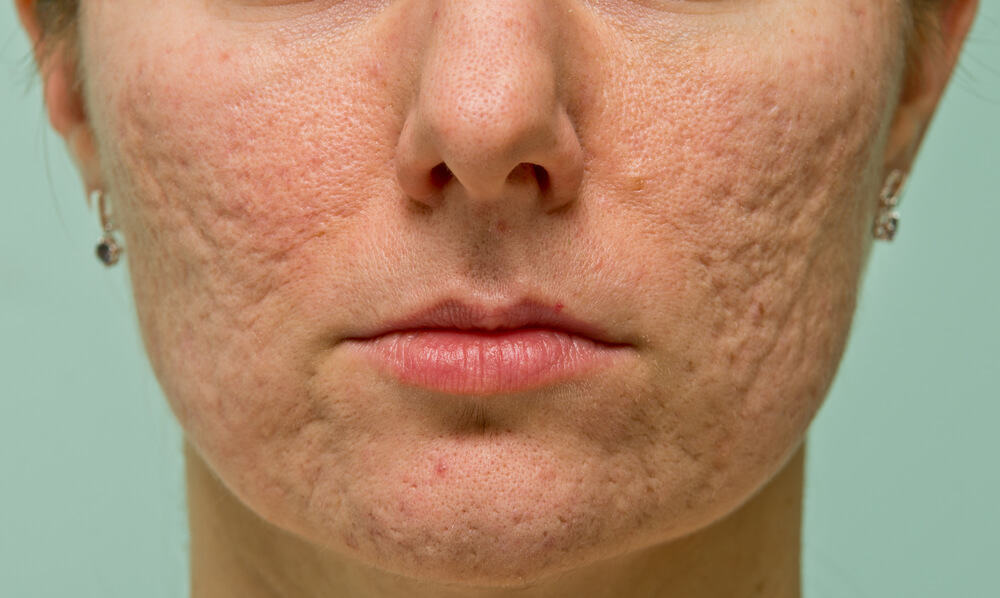
Soft tissue fillers can reduce the appearance of acne scars.
One clinical trial study of 20 subjects concluded that Poly-L-lactic acid (Sculptra) “appears to correct the types of acne scars treated in this study without serious adverse effects.”
Types of Soft Tissue Fillers
There are two types of dermal fillers: Temporary (Biodegradable) and Permanent.
This section will go over temporary soft tissue fillers since it is recommended over permanent fillers if this is your first time getting this procedure done.
Temporary soft tissue fillers are biodegradable, which means they naturally break down and are absorbed by your body over time.
Since soft tissue fillers can cause side effects if administered incorrectly, you should always make sure to receive treatment from a healthcare provider with many years of experience.
How long do soft tissue fillers last?
The effects of temporary (biodegradable) soft tissue fillers usually last from 6 to 12 months, depending on which filler is used.
Below is a list of the most common types of dermal fillers available in the U.S.:
Hyaluronic Acid
Hyaluronic acid is a type of sugar (polysaccharide) that is present in body tissues, such as in skin and cartilage, according to the FDA.
Hyaluronic acid dermal fillers (Restylane, Juvederm, Elevess, Prevelle Silk, Teosyal, Revanesse Ultra) are made from non-animal ingredients.
Hyaluronic acid fillers brands have been used to treat the following cosmetic issues:
- Nasolabial folds
- Lip augmentation (increased volume)
- Cheek Lift
- Mouth wrinkles
The effects usually last from 6 to 12 months depending on which hyaluronic acid fillers brands are used.
Temporary soft tissue fillers (such as hyaluronic acid) are not permanent. They are biodegradable, which means they naturally break down and are absorbed by your body over time.
To learn more about Juvederm, click here to be redirected to their website.
To learn more about Restylane, click here to be redirected to their website.
Calcium hydroxylapatite
Calcium hydroxylapatite (Radiesse) is a type of mineral that is commonly found in human teeth and bones according to the FDA.
Radiesse is made from a synthetic (or manufactured) calcium hydroxylapatite. It is non-animal based and has no animal protein.
Radiesse is FDA-approved for the treatment nasolabial folds (creases that extend from the corners of the nose to the sides of the mouth). It is also approved for increasing the volume on the back of the hand.
The effects last about 12 months.
Temporary soft tissue fillers (such as calcium hydroxylapatite) are not permanent. They are biodegradable, which means they naturally break down and are absorbed by your body over time.
Click here to be directed to the Radiesse website to learn more about Radiesse.
Poly-L-lactic acid
Poly-L-lactic acid (Sculptra) is a synthetic (or manufactured) substance that works differently than other fillers. It does not fill the skin like hyaluronic acid or calcium hydroxylapatite do.
Rather, Poly-L-lactic is injected into the face to stimulate your own skin’s natural ability to produce collagen, which is a protein that gives volume to your face.
Poly-L-lactic acid (Sculptra) is used to treat nasolabial folds (smile lines) and marionette lines (lines around the corners of the mouth).
It is also used in absorbable stitches according to the FDA, and it does not contain any human or animal ingredients.
The effects last about 1 to 2 years.
Temporary soft tissue fillers (such as poly-L-lactic acid) are not permanent. They are biodegradable, which means they naturally break down and are absorbed by your body over time.
Click here to be directed to the Sculptra website to learn more about Sculptra.
Autologous Fat
Autologous fat transfer involves harvesting fat from another area of your body (such as your abdomen) and placing it in areas of your face such as your lips or nasolabial folds. The fat from your own body will live there and fill in lost space.
The effects can last from months to years.
Check out this video from The Doctors TV show that explains autologous fat transfer for the jawline:
Platelet-Rich Fibrin (PRF)
Platelet-rich fibrin is a unique procedure that comes from your own blood for treating nasolabial folds.
Your blood is drawn and spun in a machine to separate out the platelets and fibrin from the other blood components.
The platelets and fibrin form a matrices that is then injected into your face, such as in the nasolabial folds. This platelet-rich fibrin stimulates growth of your own collagen.
Of the many types of cosmetic facial fillers, PRF appears to be the most natural. You are using your own tissue and not manufactured fillers.
One medical study evaluated 15 patients who were injected with platelet-rich fibrin into the nasolabial folds (smile lines). After 12 weeks, all the patients saw a reduction in appearance of their smile lines without any significant side effects.
The effects vary, lasting from 3 months to years.
To see a visual explanation of PRF, check out this video:
Cosmetic Facial Fillers Side Effects
The most common dermal facial fillers side effects are bruising, swelling, and redness. These side effects are mild and can happen early on. They can be alleviated by applying ice to the injected area.
More serous side effects of soft tissue fillers include the following and will be discussed in greater detail in the next section:
- Blood vessel blockage
- Blindness
- Late Complications: nodules, granuloma (enlarged bumps), infection
To prevent any complications following injection of soft-tissue fillers, you should see a Dermatologist or physician who has many years of experience injecting soft tissue fillers.
Your healthcare provider should also not have any malpractice lawsuits. You can discover malpractice lawsuits simply by Googling your physician’s name along with the words “malpractice lawsuits.”
Blood Vessel Blockage (Vascular Occlusion)
An important side effect that you should be aware of is that soft tissue fillers can block blood flow to your skin if it is accidentally injected into a blood vessel instead of your skin tissue. When the blood flow to skin tissue is cut off, the skin tissue can die.
To prevent accidental dermal filler injection into a blood vessel, your doctor can use a technique called aspirating the filler. To aspirate means the doctor will pull back the syringe plunger after the needle has been inserted. If no blood is pulled back into the syringe, then the needle has not hit a blood vessel, and the dermal filler is ready to be injected.
In the video below, you can see that blood was aspirated. Therefore, the filler should not be injected since the needle has hit a blood vessel.
If your doctor accidentally injects the filler into a blood vessel, there are treatments such as hyaluronidase or nitroglycerin paste to reverse the loss of blood flow due to the filler.
Blindness
Blindness can occur if the cosmetic facial filler is accidentally injected into an artery in the facial skin. If the filler travels into an artery of the eye retina, the filler will cause a blockage in the retina artery, resulting in vision loss.
The injection sites that have the highest risk of vision complications following injection of soft issues fillers are:
- Nasolabial folds
- Glabellar lines (lines between the eyebrows)
- Nose
- Forehead lines
One medical article states that there were 190 reported cases of blindness due to soft tissue fillers between 2000 and 2018:
- “90 (47%) cases were attributed to autologous fat alone, and 53 (28%) cases were caused by HA [hyaluronic acid]. The rest of the cases were attributed to collagen, calcium hydroxylapatite, and other fillers.”
Although there was a high percentage of blindness due to hyaluronic acid gel soft tissue fillers, the side effects of hyaluronic acid fillers are more reversible compared to other soft tissue fillers when treated with a reversing agent.
To prevent accidental injection of the dermal filler into a blood vessel, your healthcare provider may do one or more of the following:
- Aspirate the syringe (pull back the plunger to make sure no blood is pulled back)
- Use small needles/syringes
- Do low pressure injections
If sudden vision loss occurs during a dermal filler injection, you must be treated within 90 minutes for the best outcome. The doctor will inject a reversal agent called hyaluronidase, which will dissolve the filler. An ophthalmologist (eye doctor) should also be contacted.
This video by an ophthalmologist goes over how soft tissue fillers can cause blindness.
Delayed Cosmetic Facial Fillers Side Effects
Late complications following injection of soft tissue fillers can happen after 1 year when you received your filler injection.
Delayed cosmetic facial fillers side effects can take the form of enlarged bumps called nodules or granulomas. Sometimes you can get an infection or the filler can travel to a different location in the skin.
You should see a doctor if you have one or more of the following side effects:
- A fever that you cannot attribute to other causes
- New formation of bumps near the filler injection site or elsewhere in the body
Your doctor can treat these delayed side effects with a filler reversing medication called hyaluronidase, antibiotics, injectable steroids, or surgery.
